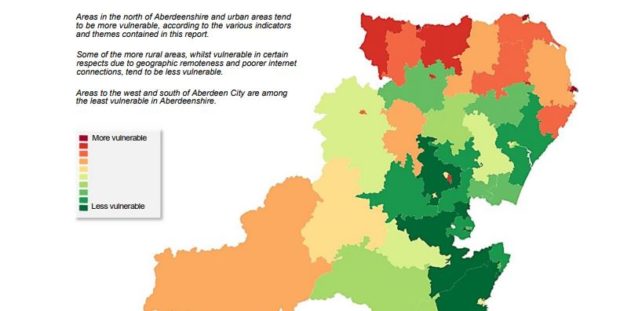Aberdeenshire Council has outlined the areas of the region most vulnerable to Covid-19 and its impact in a new report designed to help the authority make decisions to help those in greatest need of assistance due to the pandemic.
The council’s new Community Impact Assessment (CIA), which will be considered by councillors at tomorrow’s full council meeting, analysed how communities all throughout Aberdeenshire have been and continue to be affected by the virus.
As well as collecting survey data on the thoughts of residents, the council has also worked to outline the parts of the north-east that are most at-risk of turmoil brought about by Covid-19.
By combining a long list of indicators, such as the ages of populations, poverty, overall health, employment and more, the council has put together a heat map of “overall vulnerability”.
The majority of the communities considered among the 10 most vulnerable to issues created by Covid-19 are in the Banff and Buchan area.
They include Peterhead Harbour, Fraserburgh Harbour, Banff and Portsoy.
Aberdeenshire Council leader Jim Gifford said: “The reason we carried this out was to gather information from across Aberdeenshire to see exactly what impacts have happened to all of our different communities.
“As we know there are some hugely different communities from the north, south, east and west of the region, so we needed to find out exactly how everyone has dealt with the pandemic and how they’re still coping with it.
“This will be done on an ongoing basis because to put it mildly, we’re not out of the woods just yet.
“It has reinforced what we already knew, that there are some people who live in areas that to many people are outwardly affluent, but who are struggling at the best of times – and these are not the best of times.
“The pandemic has had a disproportionate impact on those living in poverty, or who don’t have the same access to jobs, cars, or public transport than others do.
“We need to make sure our council services moving into the future take notice of that and are designed accordingly.”
The council’s overall map of the region’s most vulnerable to Covid-19 was also based on indicators including superfast broadband availability, food vulnerability, levels of loneliness recorded, the number of addresses with private outdoor space, and average distances to nearest green spaces.
David Duguid, the Scottish Conservative MP for Banff and Buchan said: “This report suggests that communities in my constituency will be the hardest-hit in Aberdeenshire by the wider impact of the Covid-19 pandemic.
“It is vital, therefore, that resources and support are directed to those areas that need it the most.
“There is a balance to be struck between protecting public health and the economy.
“But our governments can and should be doing both. There is no room for complacency given the worrying findings of this report.”
Councillors at tomorrow’s full council meeting will consider the CIA and have been recommended to approve further work to be undertaken to record community views in the future, particularly for vulnerable groups.










